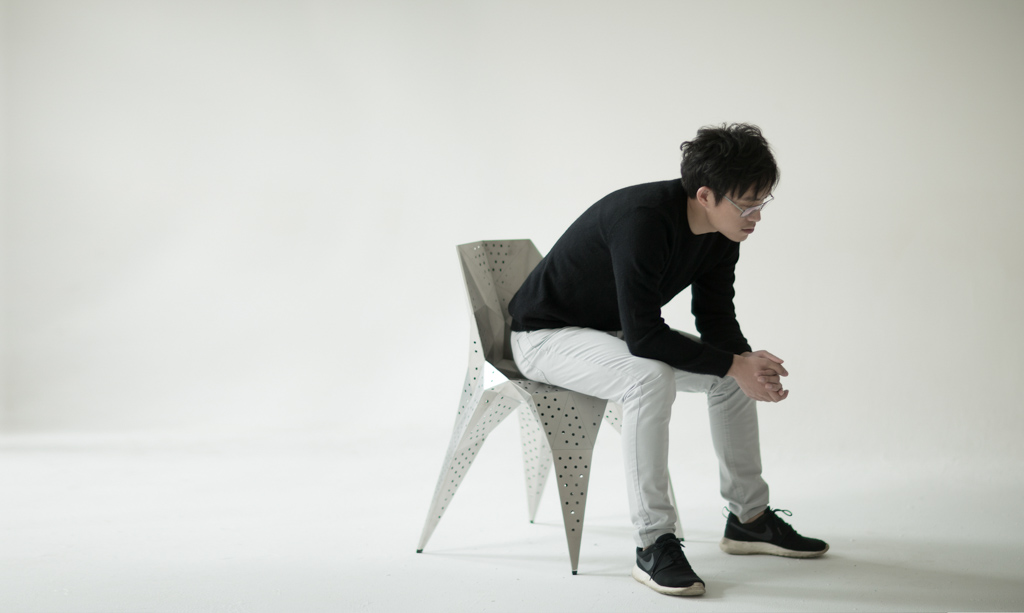This article is courtesy of Sonia Wu
During Design Shanghai in April 2018, Zhang Zhoujie unveiled his long-awaited design brand Endless Form. Spread across the West Garden of the Shanghai Exhibition Centre, an army of over a hundred chairs lay dormant.
Each intricately individualised figure is formed and perfected to serve their future master. Whilst the Terracotta Warriors were created to comfort an emperor’s transition into the afterlife, Zhang has created an army to comfort the everyday consumer into the digital era.
For over eight years, Zhang has been leading Zhang Zhoujie Digital Lab into a new era of digital design. Through the pioneering excellence of Endless Form, Zhang proves that he is not just a designer, he is an innovator.
Zhang originally studied industrial design and founded a studio with the hopes of exploring his own design direction. He was initially inspired by the progress of Artificial Intelligence when Google had first introduced their street view system, and 3D printing began to emerge. However, Zhang wished to take these pioneering technologies into the design field. So, not only is he questioning how artificial intelligence can affect lifestyle, but also injecting a digital soul into the mundane objects of everyday life.
“In the future, there will no longer be designers, just computers,” says Zhang. The individualism of each chair in Endless Form clearly display a unison between the complexities of humans with the proficiency of computers. Zhang’s years of experimentation have all been made with the hope of improving and developing a creative process in harmony with computers, “moving forward together”.
Whilst many believe that creativity is inherently human, and thus dichotomizing art and technology, Zhang is attempting to balance the advantages of both. His chairs are unique not just because of his personal input, but in how he has allowed the computer to develop his intentions freely, overcoming human limitations. In this respect Zhang sees himself as more of a creator, he describes his aim as “not about designing something, but about finding something.”
This embodies the Taoist principle of weiwuwei (为无为) otherwise known as non-action. Zhang has credited Taoism as an influence, his methodology follows the concept of the natural ‘way’ (‘dao’ 道), by living in harmony with the instability and spontaneity of the universe, and without interfering with the natural order of change.
The brand is not just innovative, it is also incredibly functional. Through intelligently-designed furniture, Zhang is promoting a tangible capitalisation of artificial intelligence, one that can mitigate our daily interaction with new technology. Just as social media is rapidly developing algorithms to customise user experiences, Zhang is bringing this method into furniture; the objects that literally shape our comfort and domestic lives. In later series, Zhang plans to give his clients direct participation in their products, further developing “man-machine integration”.
I was lucky to be able to try the chairs and found that despite the triangular planes and the metallic surface, they were incredibly comfortable, almost too comfortable. It was as if they were impressing productivity upon me by keeping me upright, giving perfect support, and no slack to slump down on. Perhaps Zhang’s real innovation was a solution for the most tedious of human limitations, laziness.
In the creation of the prototypes, Zhang and his team used their own figures as data to shape the chairs. The evidence of human impact is found in the ingenious details, making them effectively comfortable despite the futuristic avant-garde appearance. The high chair has a deep trench down the back, like two ears of a rabbit, allowing the spine of the sitter to lie within its steep grasp, others are topped with a ‘v’ to support the shoulder blades, whilst the lounge chair has a recessed back to alleviate the curve of the lower back. All the while, the smaller facets fold naturally around the contours of our bodies, creating a more customised sitting experience.
Despite the futuristic outcome, Zhang’s work is surprisingly closer to nature than one might expect. Coming from his Taoist philosophy of ‘the way’, Endless Form is a conceptual approach to the process of natural evolution. The brand name itself comes from a quote at the end of Charles Darwin’s ‘The Origin of Species’, “endless form most beautiful”. Just as organisms adapt to the changing environment, morphing their DNA from a common ancestor, Zhang’s chairs generate from species to breeds. They even have a traceable family tree exhibiting that although they are similar, they are not the same. Each has their own life and purpose, revealing the infinite variety within digital design.
Endless Form demonstrates a continuation of evolution: from organic, to manmade, to digital. Previously, furniture would be made digitally, from a naturally grown material, into a digital appearance. However, Zhang’s process is the opposite, products are formed naturally, from a manmade material into an organic appearance, the outcome of which creates a strangely familiar yet foreign appearance.
The spindly legs of the chair are spider-like yet distorted into polished shards, more like a cyborg version of a spider. The sharp fragmented forms come together with such an exaggerated dynamism as if to give his clients omnipotence over the elements; such as a tornado trapped within a coffee table, and a dining table absorbed by its core like a whirlpool. His choice of a triangular mirror mesh finish creates a digital distortion, where natural curves become pixellated. It also creates an explosive scattering of light, just like the unpredictable flow and transition of water.
Dazzling like diamonds cut to perfection, Zhang exposes the natural beauty of digital logic through Endless Form. His products are disruptively progressive, yet bridge a gap between the three pillars of our contemporary world: man, machine, and nature. His visionary concept overcomes the limitations of culture, influencing a newfound freedom of digital design that can be as diverse as nature.
His exhibition at Design Shanghai is only the beginning of what is to come, just the predecessor of a great lineage, which will surely shape the way we interact with technology and our everyday objects in the future.





















